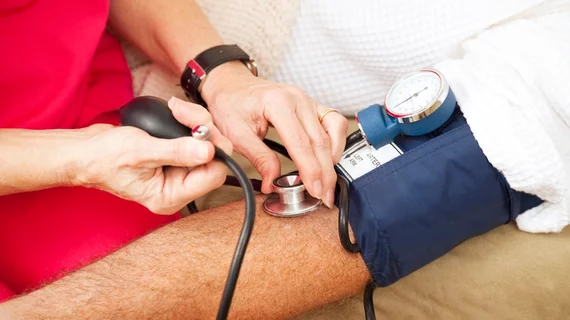Two late-breaking clinical trials presented May 23 at EuroPCR in London demonstrated the ability of renal denervation to significantly lower patients’ blood pressures, regardless of whether they were taking antihypertensive medications.
RADIANCE-HTN SOLO study
In this trial, 146 subjects were randomized 1:1 to either a sham procedure or ultrasound-based renal denervation with ReCor Medical’s ultrasound-based Paradise System. All patients were off antihypertensive medications at the time of randomization and remained off them over a two-month follow-up unless they exceeded prespecified blood pressure criteria.
On average, the reductions in daytime ambulatory systolic blood pressure were 8.5 mm Hg for the renal denervation group and 2.2 mm Hg in the placebo group.
“At two months, more than 66 percent of subjects treated with renal denervation experienced a 5 mm Hg or greater reduction in daytime ambulatory systolic blood pressure, compared with 33 percent in the sham group,” co-principal investigator Michel Azizi, MD, PhD, said in a press release. “RADIANCE-HTN SOLO also demonstrated a reduction in office blood pressure of 10 mm Hg systolic, which if durable over time, has been shown to reduce the risk of cardiovascular diseases, including stroke and heart attack, in patients with hypertension.”
Results of the trial were published simultaneously in The Lancet.
SPYRAL HTN-ON MED study
Also published in The Lancet, this randomized trial featured 80 patients assigned to either radiofrequency ablation of the renal arteries or to a sham procedure. But in this study, all patients were on one to three antihypertensive drugs at enrollment, in addition to having office systolic blood pressure between 150 and 180 mm Hg and diastolic blood pressure above 90 mm Hg.
Patients in the renal denervation (RDN) group experienced significantly greater drops in BP six months after the procedure. Compared to the sham group, their systolic blood pressures dropped an average of 6.8 mm Hg more with an office measurement and an average of 7.4 mm Hg more with a 24-hour ambulatory measurement. Diastolic BP reductions were 3.5 mm Hg and 4.1 mm Hg greater for the renal denervation group in the office and ambulatory settings, respectively.
Lead author David E. Kandzari, MD, and colleagues noted the blood pressure differences between groups weren’t significant at three months of follow-up but were more pronounced at six months. Medication adherence was about 60 percent for the entire study group.
"We are encouraged by these data showing the procedure may enable a blood pressure lowering effect 24 hours a day. RDN is essentially 'always on' even when the effect of medications may be subsiding between doses," co-principal investigator Raymond Townsend, MD, director of the hypertension program at the University of Pennsylvania, said in a press release.
The trial used Medtronic’s Symplicity Spyral system, which is currently in the investigational device stage in the U.S. and Japan. Medtronic funded the study, just as ReCor Medical funded the RADIANCE-HTN SOLO study.
Kandzari said the new results show RDN is safe and effective both in the presence and absence of blood pressure drugs. There were no adverse events reported in either group of the SPYRAL study.
Outside comment
In a related editorial, Sverre E. Kjeldsen, MD, PhD, and Murray D. Esler, MBBS, PhD, said the renal denervation studies together “inject new optimism into this exciting field of research.”
“Assuming that hidden drug use was not more common in the treatment group, RADIANCE-HTN SOLO, together with the SPYRAL-OFF and ON MED trials … might provide the first true trial evidence that renal denervation lowers blood pressure,” they wrote. “These trials thus open a new chapter in renal denervation research and in our view should not be grouped into the meta-analyses of the first wave of studies.”
The editorialists pointed out the blood pressure drops observed in the studies are equivalent to what would be expected from one effective antihypertensive drug. Given patient adherence issues occur in drug therapy, a more permanent approach such as RDN could be a better option for some patients.
But further research should identify which patients benefit the most, the editorialists noted, and extend follow-up to measure long-term effects on blood pressure and downstream cardiovascular events. In addition, cost-effectiveness analyses will need to be performed.

